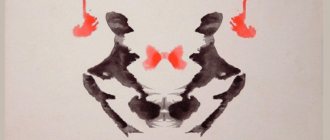Projective techniques are based on the study of the products of fantasy and imagination; they are able to reveal the inner world of a person. We live in an interesting world, where every phenomenon can please and surprise. But each person sees this world in his own way. Some people admire the beauty of nature, some see danger everywhere, and some are indifferent to this. And this behavior directly depends on what is inside a person. If he is happy with life and does not have any particularly serious problems, then he projects this into the outside world. It is projective techniques that can show a psychologist what is going on in a person in his inner world. What methods can tell us about this? Let's find out!
Fundamentals of projective diagnostics, purpose
The projective method is based on the creation of special situations in which there are many variations. This type of technique uses incentives. The subject independently develops and supplements them.
For example, he may be asked to complete a particular sentence or complete a drawing. In this case, the answer to the question is not right or wrong, but only allows the specialist to assess aspects of the subject’s personality.
Depending on how the person responds, the doctor identifies possible problems and can determine how to proceed with the patient. For the subject himself, the final goal of projective diagnostics is hidden, so he cannot consciously achieve the desired result.
General characteristics of projective techniques
The word “projection” itself was introduced by S. Freud. He used his techniques to define a type of psychological defense. When a person defends himself from his own hidden desires of an asocial type, he projects (or transfers) them onto the people around him.
Later, projection began to be considered more widely in psychodiagnostics. This concept means how well a person is able to reflect his desires, emotions, etc. Projection refers to behavior as well as views of the world around us.
However, projective techniques differ significantly from other psychodiagnostic tests.
First of all, these techniques:
- They allow you to fully characterize the patient’s personality, rather than highlight any one quality or property.
- The techniques are based on the patient’s experience, as well as on his associative thinking.
- The subject receives complete freedom in his answers.
- Very often creative tasks are considered that allow one to reveal a person’s potential.
Classification by principle of use
Projective techniques in psychology are relatively new and very diverse. The most detailed classification was presented by L. Franclon. He identified 8 types of techniques.
| Type of technique | Description |
| Expressive | The technique helps to study human emotionality. His activities are considered. For this direction, a drawing technique is used. In this case, the test requires the subject to create an image. For example, a specialist may ask you to draw a non-existent animal. |
| Impressive | This technique usually uses cards or pictures. They are objects of so-called stimulus material. These tests allow you to assess a person’s mental state. This technique includes the M. Luscher test. |
| Constructive | During the test, the subject is asked to assign meaning to a particular image. For example, this type of technique includes the Rorschach test. |
| Interpretative | The subject is also asked to look at the images. He must explain the meaning of the pictures and what is happening in them. |
| Constructive | These techniques use figures, pictures, and even a construction set, from which the patient is asked to create logical scenes. After creating such objects, a person must describe them. |
| Cathartic | In this case, the specialist tries to induce a state of catharsis in the patient. This allows us to fully reveal his mental characteristics. Thanks to such methods, a person himself begins to realize his problems and determine their source. |
| Refractive | The specialist pays attention to what reservations or typos the patient makes. Such methods are often used when working with adolescents. |
| Addictive | Addiction is how dependent a person is on a particular activity or behavior. Such methods are used when working with drug addicts, alcoholics and people with other addictions. The doctor assesses what even simpler habits the person has. For example, he may bite his lip, bite his nails, etc. |
Thanks to such a variety of types of techniques, psychologists have a huge arsenal of different tests. However, projective techniques are considered quite controversial by some.
2.2. Projective hypothesis and projective techniques, their types
Library » Techniques » Projective techniques
© L.F. Burlachuk
Introduction to projective psychodiagnostics
««« To the beginning
The first description of the projection process in a situation with stimuli that allow for different interpretations belongs to the famous American psychologist G. Murray (1938). He views projection as the natural tendency of people to act under the influence of their needs, interests, and entire mental organization. In fact, this is the first application of the concept of projection to psychological research. At the same time, G. Murray, who is well acquainted with psychoanalytic work, believed that defense mechanisms during the process of projection may or may not appear. Until this time, the theoretical concept of projection in the form in which it is applicable to the study of personality had not been formulated.
To designate a certain type of psychological techniques, the concept of projection was first used by L. Frank in 1939. (We will refer to a more complete study by this author, published in 1948). He puts forward three basic principles underlying the projective study of personality:
1. Aimed at what is unique in the structure or organization of the individual. In contrast to traditional psychometric procedures, personality is considered as a system of interconnected processes, and not a list (set) of abilities or traits,
2. Personality in the projective approach is studied as a relatively stable system of dynamic processes organized on the basis of needs, emotions and individual experience.
H. This system of basic dynamic processes constantly, actively operates throughout the life of an individual, “forming, directing, distorting, changing and reshaping each situation into a system (configuration) of the individual’s inner world.” Every new action, every emotional manifestation of an individual, his perceptions, feelings, statements, motor acts bear the imprint of his personality. This third and main theoretical position is usually called the "projective hypothesis".
Defining the specifics of the projective approach, L. Frank writes that this is a technique for studying personality, with the help of which the subject is placed in a situation, to which he reacts depending on the meaning of this situation for him, his thoughts and feelings. It is also emphasized that the stimuli used in projective techniques are not strictly unambiguous, but allow for different interpretations. A stimulus acquires meaning not simply because of its objective content, but primarily in connection with the personal meaning attached to it by the subject.
L. Frank does not consider projective techniques as a replacement for already known psychometric ones. The purpose of these techniques is to study the “idiomatic” internal sphere, which can be considered as a way of organizing life experience. Projective techniques successfully complement existing ones, allowing you to look into what is most deeply hidden and escapes when using traditional research techniques.
The following features are common to all projective techniques:
1. Uncertainty, ambiguity of the stimuli used.
2. No restrictions in choosing an answer.
3. Lack of assessment of the test subjects’ answers as “correct” or “wrong”.
L. Frank was the first to develop a classification of projective techniques. This classification, despite the abundance of others, with the changes and additions proposed later, is today the most fully characterizing projective technique. Let's take a closer look at the classification of projective techniques.
Constitutive projective techniques.
The subject is offered some amorphous material to which he must give meaning. An example is the Rorschach technique, which consists of 10 tables depicting symmetrical single-color and polychrome images - spots that can be easily obtained by applying a little ink or paint to a sheet of paper, and then folding this sheet in half (for examples of stimulus material for projective techniques, see final section). The subject is asked only one question: “What could it be, what does it look like?” It is believed that in the process of interpreting images and giving them meaning, the test subject projects his internal attitudes, aspirations and expectations onto the test material. Detailed, sometimes occupying several volumes, schemes for interpreting the subject’s answers have been developed (for more details, see: Burlachuk L.F. Personality Research in Clinical Psychology. - K.: Vishcha Shkola, 1979).
Constructive projective techniques.
Designed details are offered (figurines of people and animals, models of their homes, etc.), from which it is necessary to create a meaningful whole and explain it.
The World Test, for example, consists of 232 models of objects distributed in different proportions across 15 categories (houses, trees, planes, people, animals, etc.). The subjects construct a “small world”, and based on its many features, taken into account by the researchers, conclusions are drawn about the personality of the “constructor”.
Interpretive techniques.
It is necessary to interpret, interpret any event or situation. The thematic apperception test is a good illustration of this type of technique. The subject is offered table-pictures that depict relatively vague situations that allow for ambiguous interpretation. During the examination, the subject is given a short story in which it is necessary to indicate what led to the depicted situation, what is happening at the present time, what the characters are thinking about, what the characters are feeling, how this situation will end. It is assumed that the subject identifies himself with the “hero” of the story, which makes it possible to reveal the inner world of the subject, his feelings, interests and motives.
Cathartic.
It is proposed to carry out gaming activities in specially organized conditions. For example, psychodrama, carried out in the form of an improvised theatrical performance, allows the subject not only to react affectively (playful catharsis) - and thereby achieve a therapeutic effect - but also gives the researcher the opportunity to discover conflicts, problems, and other personally rich products that are externalized.
Refractive.
The researcher seeks to diagnose personal characteristics and hidden motives by those involuntary changes that are introduced into generally accepted means of communication, for example, speech, handwriting.
Expressive
. The subject carries out visual activities, drawing on a free or given topic, for example, the “House-Tree-Man” technique. It is suggested to draw a house, a tree and a person. Based on the drawing, conclusions are drawn about the affective sphere of the personality, the level of psychosexual development and other characteristics.
Impressive.
These projective techniques are based on studying the results of choosing stimuli from a number of proposed ones. The subject selects the most desirable, preferred stimuli. For example, the Luscher test, consisting of 8 colored squares (incomplete set). All squares are presented with a request to choose the most pleasant one. The procedure is repeated, and as a result a row is formed in which the colors are arranged according to their attractiveness. The psychological interpretation comes from the symbolic meaning of color. Virtually any objects of living and inanimate nature can act as stimuli.
Additive.
In these projective techniques, the subject is required to complete a beginning sentence, story, or story. For example, a series of unfinished sentences is offered such as: “The future seems to me...”, “I think that a real friend...”, etc. These techniques are designed to diagnose a variety of personal variables - from the motives of certain actions to attitudes towards sex education for young people.
Concluding this section, it must be said that the use of the concept of projection to designate the methods under discussion raises objections among some well-known psychologists.
For example, R. Cattell prefers to call them “misperception tests.” L. Bellak writes about “apperceptive distortion.” However, attempts to replace the name of this group of techniques were not successful, and most researchers accept their historical designation as projective.
"""Back To top Forward"""
Advantages and disadvantages of projective techniques
Projective techniques in psychology have many positive aspects. Projective surveys and tests can significantly reduce the patient’s anxiety level and diagnose children who cannot yet read. Also, such techniques help to determine a person’s hidden motives, even if he himself is not aware of them.
But some specialists categorically refuse to use projective diagnostics. They argue that such tests give too vague results.
Projective techniques in psychology. Advantages and disadvantages
In such surveys and other applications of the methodology, there is no standard scale that would allow the results to be assessed and classified. The surveys themselves are conducted in an uncontrolled manner. When assessing the results, a specialist, especially if he is inexperienced, may be biased.
Novice psychodiagnosticians do not agree with these shortcomings. They claim that working with such methods is very simple, and thanks to the huge variety of tests, their information content also increases.
Recommendations for the use of projective techniques
Projective techniques are not fundamental in research, even though they are such a powerful diagnostic tool. But if this kind of tests becomes the subject of choice, you need to take into account the features of using projective techniques:
- it is important to comply with all prescribed conditions for the test;
- interpretation must be carried out by at least 3 competent specialists;
- properly selected incentives;
- the chosen methods must correspond to the stated objectives of the study.
Features of application
Projective techniques are widely used in various fields: surveys, pictures and other methods have proven to be very effective in conducting forensic psychiatric examinations. Projective methods are often used when counseling not an individual patient, but a whole group of people; they are often used in employment centers or during personnel changes.
In the process of work, the specialist must take into account the patient’s age and emotional characteristics. The psychologist also pays attention to the mental data of the subject, his social status, marital status and many other factors.
For adults
If an adult is diagnosed, he deliberately tries to choose the best answers. That is, the patient tries to predict the psychologist’s behavior. Thanks to projective tests, it is impossible for a person to determine the best answer, since it does not exist. In the process of work, the doctor can diagnose phobias, frustrations and other deviations.
For children
Projective techniques used in psychology are applicable to children. In this case, images and other types of graphic techniques are used. The psychologist can also invite the patient to draw any animal that comes to the child’s mind. It is much easier to work with such patients, as they behave as sincerely as possible.
For group diagnostics
When working with a large group of people, all diagnostic options are applicable. For example, you can use graphic images and conduct surveys. In this case, the work is carried out according to the principle of a sports team, work or student group. Patients can draw together. Such methods can reduce aggression when working with other people.
Examples of projective methods
There are several most applicable and popular diagnostic methods.
Rorschach technique (Ink Blot Test)
This technique was developed by the famous Swedish psychiatrist G. Rorschach. She began working on the Ink Blot Test back in the 1920s. This is a projective test, which consists of asking the patient to look at 10 cards on which blots of different shapes are depicted. The images are symmetrical.
The patient must say what exactly he sees in the pictures, more accurately describe what the blots look like. This is an extremely simple and quick test that takes much less time than questionnaires that can have up to 100 questions. The Rorschach test requires a person to give a monosyllabic answer.
The doctor evaluates him according to five main criteria:
- Popularity or originality. Most people see the same thing in the pictures. If 9 subjects say that they see a butterfly, and 10 see a skull, then his answer is considered the most original.
- Content. This is what exactly a person sees in the image: a butterfly, a bird, a fantastic creature, etc.
- Localization. It is necessary to determine the area that the patient was looking at at the time the image was described. Perhaps the subject concentrated on one element of the picture or looked at it in general terms.
- Determinant. We are talking about shape, color and other details that the subject was able to see.
- Form level. It is necessary to assess how well what a person sees corresponds to the image.
After clarifying these criteria, the doctor must interpret the results obtained with the utmost precision. Such a test should only be carried out by a qualified psychologist who has the necessary experience and skills in working with patients.
Cactus
The main purpose of this test is to identify the emotional state of the child. The doctor determines how aggressive he is and to what extent his dissatisfaction is manifested. This diagnostic test is applicable when working with patients over 4 years of age. For the test you need a sheet of paper and a pencil. The psychologist asks the patient to draw a cactus, the way the child imagines it.
After this, the doctor asks the subject a series of additional questions. He should not rush the child; there is no time limit for this test. During the conversation, the psychologist asks what kind of cactus the child drew: wild or growing at home. The patient must tell what the plant will be like when it grows, whether it can be touched, and how to properly care for it.
If a child draws a cactus with a large number of needles, which are long and extend far from the trunk of the plant, then this indicates aggressiveness. If the lines are broken or the patient has been making too much use of the pencil, then this characterizes him as a rather impulsive person.
A self-centered person will draw a large cactus located in the center of the leaf. And if, on the contrary, the plant is very small and drawn in the corner of the sheet, then the child will show dependence and self-doubt. Bright colors in the picture indicate optimism, while dark colors indicate hidden anxieties. If the cactus is located in a flower pot, then this is a sign of the need for protection.
Sondi test
The official name of the test is Szondi-test. This is a type of project technique that was developed by L. Szondi in 1939. During testing, the doctor asks the patient to look at 6 series of photographs, 8 pictures each.
The cards depict the faces of people who suffer from certain mental disorders or diseases. The subject must choose from each series two images that seem least attractive to him.
If a patient selects 4 or more images that demonstrate the same disease, then it is highly likely that he himself suffers from such a deviation. In this case, it does not matter whether the subject has a negative or positive attitude towards such pictures.
Tree
Projective techniques in psychology are predominantly graphic. The Tree test is one of them. It was developed by E. Juckert. The patient is asked to draw a tree, which in psychology is often called a “frozen gesture.” This test has been changed several times over the years.
To complete the test, you must ask the subject to draw any tree that he likes. After this, the doctor also conducts a conversation with the patient, asking questions about the drawn tree. For example, you can specify the type of tree, its age, and height. After this, the specialist tries to evoke associations in the patient.
He asks who the tree looks like. You can even clarify his gender. The tree may have dreams, desires, or, on the contrary, it will be dead for the subject.
The doctor also evaluates the drawing itself. For example, a patient drew a spruce tree with a lot of details, branches, and the needles are very clearly drawn, then this indicates a tendency towards dominance.
Drawing test “Non-existent animal”
This test is recommended when working with teenagers and high school students. This is a fairly simple but very informative test. To do this, the patient needs to be given a piece of paper, a pencil and asked to draw some animal that does not actually exist.
In this case, the patient should not take as a basis the characters of fairy tales or what he saw in a science fiction film. It is important that he comes up with the character himself. The patient must also come up with a name for this animal.
When assessing a drawing, the psychologist also determines its size, location and other factors. For example, the type of lines can indicate a person’s energy. If he presses hard on the pencil, then he is very active, but barely noticeable lines indicate that the patient is constantly suffering from a lack of energy.
It is worth paying attention to the size of the character's head. The greater it is, the more attention the patient pays to the reasonable regulation of his behavior. If he drew an animal with a very small head, then he is guided by fleeting desires, bodily urges.
School of Animals
A similar test is performed when working with children who are just going to school. At this stage, the child experiences problems, but he is not yet able to get out of difficult situations on his own. To work, you need to prepare colored pencils or crayons and a sheet of paper. After this, you need to invite the child to imagine himself in a forest clearing on a sunny day.
In this clearing he should try to see the “School of Animals”. After this, you should ask him to draw all the students and tell them what they do. Next, you need to clarify with the patient what kind of animal he sees himself in this unusual school. At the same time, the child is limited in time. He must determine while the specialist counts to 10.
Having received the answers, the psychologist also evaluates all the drawings and conducts a conversation.
Projective technique “Sentence completion” (for egocentrism)
This technique allows you to assess the level of egocentrism in the patient. This is a study that must be conducted according to accepted standards in psychology. At the same time, the specialist receives a lot of information.
It is worth considering that egocentrism is not a diagnosis, but only an indicator of deeper personal problems. In fact, egocentrism is a symptom of many disorders, such as neurosis or psychopathy.
To carry out the diagnosis, the doctor gives the patient a sheet with 10 incomplete sentences. The subject must complete these sentences as quickly as possible and try not to think about what he is writing. For example, a person must tell what happened several years ago.
When studying the answers, the doctor pays attention to how many times in 10 sentences the patient wrote “I”, “me”, “mine” and other personal derivatives. If the patient uses such words no more than 1-3 times, then he does not have serious problems. Those people who write to themselves in almost every sentence (and this is not the purpose of the test) have great egocentrism.
Projective technique “My holidays”
Projective techniques in psychology allow you to work with patients of almost any age. This test is used by professional psychologists to determine the type of emotional orientation of the patient. The results must be assessed very carefully, so this test is not suitable for beginners. This technique is performed for patients over 10 years of age.
The test is given 15 minutes. During this time, the subject must imagine that all the holidays have disappeared. Now he must come up with a new holiday for every month, 12 in total.
In this case, you cannot use those activities that already exist. That is, the patient must come up with his own holidays and arrange them by month. At the same time, from the name of the holiday it should be clear what exactly is being celebrated, for example, “Dinosaur Day.”
After this, the doctor excludes those options that are too similar to real holidays. The remaining options are evaluated, and the specialist determines the emotional orientation of the subject’s personality using a point system. For each original holiday, the specialist gives 2 points. If multiple holidays fall into the same category, points will be deducted.
Family drawing
This is a test that combines several methods to assess intrafamily relationships. In this case, the images are also evaluated; the work is carried out mainly with children.
This diagnostic technique was first considered by K. Machover in 1949. After that, this testing was constantly refined. Today this technique is also called Wolfe drawing. According to this test, the child is asked to draw sequentially all the members of his family.
The doctor pays attention to the location of people in the picture. The fact that the subject did not draw someone from his family is also taken into account. According to the proportions of the people depicted, you can determine who in the family is the greatest authority for the child.
However, in his works, Wulf did not give a clear formulation and definition of each feature of drawing. Most of all, he paid attention to consistency. That is, the one whom the child drew first is the most important person for him.
This graphic testing system was modified by V. Hules. He suggested analyzing not only the sequence and the finished result, but also the drawing process itself. He paid attention to what emotions the patient experienced while drawing family members.
The most modern version of this research method is based on the graphic quality of the image. The specialist takes into account the lines, the pressure on the pencil, how accurately the drawing is made. It is also important on which part of the sheet the child draws his family: in the middle of the sheet or somewhere in the corner. After this, the formal structure needs to be assessed.
The specialist examines the dynamism of the drawing. The next step is to evaluate the content itself. The doctor may ask the child clarifying questions. For example, he can find out why the patient decided to draw his mother much taller than his father, although in reality the opposite is true.
Additionally, professional psychologists recommend asking provocative questions. The specialist's task is to encourage the child to reveal his emotional state and attitude towards parents, brothers and other family members. To do this, a psychologist can ask who the child is considered the best and worst in the family. Experts also often ask so-called sociometric questions.
This means that the answers to them can only be negative or positive. For example, you can ask your child what he thinks if there is no room in the car for everyone in his family, which members of his family will have to refuse the trip. Ultimately, the psychologist must clearly determine what the child depicted and what the hierarchy in his family is in his opinion. It's important to pay attention to detail.
Modern design techniques are often discussed in psychology. Although some experts do not recommend using such tests, there are those who believe that these techniques are very effective and easy to use. However, in any case, resorting to such diagnostic measures can only be done by studying these methods and their varieties in detail.
Review of basic techniques
Rorschach blots
The projective method of personality research, published in 1921 by the Swiss psychiatrist and psychologist Hermann Rorschach.
A person is given 10 pictures of spots. After this, he is asked to describe what he sees. Next, the specialist interprets the results of the answers and draws a conclusion about the mental state of the subject.
Read more about the methodology in this article: Psychological Rorschach test: interpretation of results.
Drawing "Man in the Rain"
In this method of psychodiagnostics there are no restrictions in choosing an answer and assessing the test subjects’ answers as “correct” or “wrong”.
The test will help diagnose personal reserves and characteristics of a person’s defense mechanisms and his ability to overcome difficult life situations.
Using this test, you can track a person’s adaptation to a new team.
It is recommended to perform this technique for children over 9 years of age, as well as for adults. You can draw with any tools:
- with a simple pencil;
- paints;
- felt-tip pens;
- colored pencils;
- crayons, etc.
3 important steps
which every woman should go through
Anika Snagovskaya
Author and presenter of women's trainings on harmonizing feminine energy. Master of removing limiting beliefs and master of constellations.
I have prepared three lessons for you that will help you better understand yourself, remove the restrictions that prevent you from feeling loved and living happily.
01
Video lesson with meditation: 5 states of femininity
You will learn about 5 female states that exist in every woman, how they manifest themselves and which archetypes are most manifested in you and which are not developed.
02
Video lesson + meditation: How to let go of past relationships
I’ll tell you what you need to do to free your heart from old feelings and break the energy threads connecting you with your past partner.
03
Audio recording: Neuro-af
Thanks to this neuro-affirmation, you can regain self-love and feel sincere gratitude and happiness for every day.
✕
Take your gifts!
What to do? Draw two pictures:
- On one - just a man
- On the second - a man in the rain
Read more about the methodology and analysis of the test results in the article: Test “Man in the Rain”: interpretation and examples.
Constructive drawing of a man from geometric shapes
The Libin psychographic test is a diagnostic system that combines any image of a human figure with an unconscious semantic (notional) determination of the meaning of the geometric shapes of the drawing.
The test is used for psychological diagnosis of personality, character traits, interpersonal relationships and characteristics of the nervous system. After analyzing its results, we can say that there are 8 personality types.
This technique provides interpretation at seven levels, but there is also an online version of the test. But only two of the seven levels are already applied there.
How to pass the test? Draw a ten-element human figure on an A4 quarter sheet of paper using triangles, circles and squares.
Read more about how to take the test and interpret the results in the article: Psychogeometry: how to determine character from drawings of geometric shapes.
Projective technique “Tree Drawing”
The “Tree Drawing” test was founded by a female psychologist from the USA, F. Goodenough. She dealt with problems of children's psyche. After her, Karen Machover created a system of criteria that help evaluate personality traits using this test.









